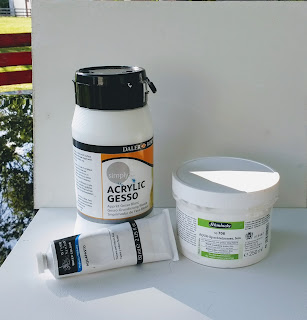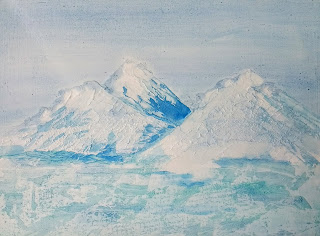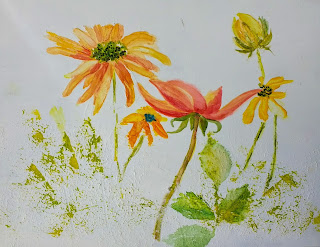
You can use these on watercolor paper (preferably 300 pound for the gesso) or hard board. This would also be fun with cradle board. (No framing necessary)
If doing a board, put three coats of gesso on first, drying completely between layers. If doing paper, you can just do one layer. You can have fun with the textures just with the gesso:
*put some sand in it
*lay potato bag over it
*use a palette knife to create textures
*drag a comb through it
*use color shapers to poke shapes in it
*press leaves into it
*TINT it with tube color
The watercolor modeling paste is lighter than the gesso, about the weight and consistency of beaten egg whites. You can buy it fine or coarse, depending on the texture you are after. You can put this directly on watercolor paper with or without gesso. It dries faster than the gesso, and doesn't seem to crack on a flexible surface. It seems to make peaks better than the gesso does, and you can use all the suggested texturing devices listed for gesso.
This picture is gesso on board, with water color modeling paste over it. (Not a work of art, but a good example of the texture you can create)

Aquapasto comes in a tube like toothpaste. It is a thick, clear gel. You can mix it with tube watercolors or apply it clear and paint over it. It creates an impasto look. Aquapasto looks glossy when dry, whereas the modeling paste leaves a duller look. It can be watered down and removed from the surface also.
In the picture below, I have aquapasto on the right yellow daisies and the centers of the flowers. The red flower is done just on smooth gesso. The petals on the daisy on the left are done over modeling paste. You probably can't see it, but the paint is duller than the centers and the daisies on the right. There is modeling paste on the bottom with leaves pressed into it.

The advantages of gesso and modeling paste are also its DISadvantages. Paint doesn't slip and slide like Yupo paper does, so you have more control over hard lines. The paint is easily removed with a little water, making it easy to remove mistakes. However, it also makes it hard to glaze over with another color. You almost have to paint ala prima: "first time." If you are painting over an area, make certain that it is with a light touch so you don't disturb your first coat of paint.
Another advantage is that if you don't like something, you can gesso over it and start over.
Disadvantages of aquapasto is it leaves a sticky film. Yes, you can remove it, but it is also quite sticky until it dries. Then, if it is rewet, it is sticky again. I would be concerned about it sticking to the glass in a frame if it became humid. I think it would have to be varnished over to prevent that.
GESSO DIRECTIONS:
Apply a coat of gesso onto your paper or board using a rough brush. While it is still wet,

No comments:
Post a Comment